Coordinated Spatio-Temporal Operation of Wind–Solar–Storage-Powered Data Centers Considering Building Thermal Inertia
Abstract
1. Introduction
- (1)
- Based on the differentiated needs of users, the spatio-temporal flexibility of data loads is deeply explored, which enables DC to reduce the operation cost by leveling and transferring the data loads;
- (2)
- Considering the building thermal inertia of the DC, a mathematical model of the DC taking into account the building thermal inertia is established, and the quantitative mathematical relationship between air-conditioning power, data load rate, and building parameters is given;
- (3)
- We propose a coordinated spatio-temporal operation of wind–solar–storage-powered DCs considering building thermal inertia, which improves the consumption of renewable energy and realizes the green transformation.
2. Problem Description
3. Mathematical Formulation
3.1. Objective Function
3.2. DC Energy-Consumption Model
3.2.1. IT Equipment Model
3.2.2. Air-Conditioning System Model
3.2.3. PV Model
3.2.4. WF Model
3.2.5. ES Model
3.3. Constraints
3.3.1. Data Load Rate Constraints
3.3.2. Aggregate Service Rate Constraints
3.3.3. Maximum Response Time Constraints
3.3.4. Indoor Temperature Requirements
3.3.5. Maximum Data Load Rate Constraint
3.3.6. Server Operating Frequency and Service Rate Constraints
3.3.7. Air-Conditioning Operational Constraints
3.3.8. Renewable Energy Capacity Constraints
3.3.9. ES Multiplier Constraints
3.3.10. Power Balance Constraints
4. Case Studies
4.1. Basic Data
4.2. Results Analysis
5. Conclusions
- (1)
- By digging deeper into the temporal and spatial flexibility of loads, each DC can be enabled to significantly reduce DC operating costs by rationally migrating loads from periods of high tariffs to periods of low tariffs and by optimizing the distribution of loads between different DC;
- (2)
- It is vital to fully take into account the building thermal inertia of DC, as this will significantly reduce the energy consumption of air-conditioning systems while guaranteeing the normal operating ambient temperature of servers in DC;
- (3)
- The proposed strategy of DC integrated with wind, solar, and ES can reduce the operation cost of the DC by 37.92% and improve the level of renewable energy consumption.
- (1)
- Conduct significance tests and sensitivity analyses, define error margins, and evaluate the strategy’s robustness under complex conditions to ensure reliable and generalizable results;
- (2)
- Explore limitations related to renewable energy availability, scalability, and real-world constraints to enhance the practical applicability of the research.
Author Contributions
Funding
Data Availability Statement
Conflicts of Interest
Symbols and Abbreviations
| List of abbreviations | ||
| Data Center | DC | |
| International Energy Agency | IEA | |
| Information Technology equipment | IT equipment | |
| Photovoltaic power plant | PV | |
| Wind farm | WF | |
| Energy storage | ES | |
| List of symbols | ||
| / | Power purchased from the grid for DC A and B (kW) | |
| / | PV output for DC A and B (kW) | |
| / | WF output for DC A and B (kW) | |
| / | Charge/discharge power of the ES for DC A (kW) | |
| / | Charge/discharge power of the ES for DC B (kW) | |
| // | Operation and maintenance cost coefficients of WF, PV, and ES (CNY/kWh) | |
| Purchased price of the electricity (CNY) | ||
| Total power consumption of the DC (kW) | ||
| Power consumption of the IT equipment (kW) | ||
| Power consumption of the air-conditioning system (kW) | ||
| Power consumption of the power distribution and lighting system (kW) | ||
| Fixed portion of the power distribution and lighting system (kW) | ||
| Power of class m server in s operating state (kW) | ||
| / | Static/dynamic power of the server (kW) | |
| km/fm | Dynamic power calculation coefficient of class m server/chip operating frequency | |
| The amount of heat change in the room of the DC (kW) | ||
| /C/V | Air density (kg/m3)/heat capacity(kg·K)/volume (m3) | |
| / | Temperature of the room/outdoor temperature (°C) | |
| / | Heat transfer coefficient from the external wall/window | |
| / | Area of the wall/window (m2) | |
| I/ | Intensity of light/shading coefficient | |
| / | The power of heat dissipation of the IT equipment/cooling capacity | |
| Energy efficiency ratio | ||
| Probability density function of solar luminous intensity r | ||
| /a,b | Gamma function/shape parameters | |
| // | Light intensity, PV array temperature (°C)/maximum output power (kW) | |
| k | Temperature coefficient | |
| Surface temperature of the PV array (°C) | ||
| // | Wind speeds (m/s) | |
| R | Blade length (m) | |
| Specified power of the fan (kW) | ||
| // | Self-discharge efficiency/charging efficiency /discharging efficiency | |
| / | ES capacity at time t and time t − 1 (kW) | |
| // | Charging/discharging power/total power of the electricity traded (kW) | |
| / | The amount of electricity in the beginning/the end of the time of the ES (kW) | |
| / | Interactive load rate/batch load rate (bar/s) | |
| / | The sum of the service rates of the servers/service rate of m types of servers in DC i in the s state (bar/s) | |
| / | Service rate for interactive load/batch load (bar/s) | |
| / | Service rate for interactive load/batch load after space-time regulation (bar/s) | |
| / | Maximum response time of the interactive load/Load transfer delay time (s) | |
| Maximum response time of batch load (h) | ||
| / | Lower and upper limits of the indoor temperature (°C) | |
| Maximum amount of data load (bar/s) | ||
| H/ | Type of operating frequency that the server can choose/selection variable for the time slot operating frequency and service rate | |
| Upper limit of the power of the air-conditioning system (kW) | ||
References
- International Energy Agency (IEA). Data Centers and Data Transmission Networks; World Energy Outlook; IEA: Paris, France, 2022. [Google Scholar]
- Liu, Y.; Wei, X.; Xiao, J.; Liu, Z.; Tian, Y. Energy consumption and emission mitigation prediction based on data center traffic and Pue for global data centers. Glob. Energy Interconnect. 2020, 3, 272–282. [Google Scholar] [CrossRef]
- Ding, Z.; Cao, Y.; Xie, L.; Lu, Y.; Wang, P. Integrated stochastic energy management for data center microgrid considering waste heat recovery. IEEE Trans. Ind. Appl. 2019, 55, 2198–2207. [Google Scholar] [CrossRef]
- Wang, J.; Deng, H.; Liu, Y.; Guo, Z.; Wang, Y. Coordinated optimal scheduling of integrated energy system for data center based on computing load shifting. Energy 2023, 267, 126585. [Google Scholar] [CrossRef]
- Chen, M.; Gao, C.; Shahidehpour, M.; Li, Z.; Chen, S.; Li, D. Internet Data Center Load Modeling for Demand Response Considering the Coupling of Multiple Regulation Methods. IEEE Trans. Smart Grid 2021, 12, 2060–2076. [Google Scholar] [CrossRef]
- Zhai, X.; Li, Z.; Li, Z.; Xue, Y.; Chang, X.; Su, J.; Jin, X.; Wang, P.; Sun, H. Risk-averse energy management for integrated electricity and heat systems considering building heating vertical imbalance: An asynchronous decentralized approach. Appl. Energy 2025, 383, 125271. [Google Scholar] [CrossRef]
- Wang, P.; Sun, J.; Yoon, S.; Zhao, L.; Liang, R. A global optimization method for data center air conditioning water systems based on predictive optimization control. Energy 2024, 295, 0360–5442. [Google Scholar] [CrossRef]
- Nadjahi, C.; Louahlia, H.; Stéphane, L. A review of thermal management and innovative cooling strategies for data center. Sustain. Comput. Inform. Syst. 2018, 19, 14–28. [Google Scholar] [CrossRef]
- Ding, B.; Li, Z.; Li, Z.; Xue, Y.; Chang, X.; Su, J.; Sun, H. Cooperative Operation for Multiagent Energy Systems Integrated with Wind, Hydrogen, and Buildings: An Asymmetric Nash Bargaining Approach. IEEE Trans. Ind. Inform. 2025. [Google Scholar] [CrossRef]
- Li, Y.; Wang, B.; Xue, F. Research on the Current Development Status of Energy Storage Technologies. Power Gener. Air Cond. 2017, 38, 56–61. [Google Scholar]
- Xie, Y.; Cui, Y.; Wu, D.; Zeng, Y.; Sun, L. Economic analysis of hydrogen-powered data center. Int. J. Hydrogen Energy 2021, 460, 27842–27850. [Google Scholar] [CrossRef]
- Zhou, K.; Fei, Z.; Lu, X. Optimal energy mangement of internet data center with distributed energy resources. IEEE Trans. Cloud Comput. 2023, 11, 2285–2295. [Google Scholar] [CrossRef]
- Zhang, G.; Zhang, S.; Zhang, W.; Shen, Z.; Wang, L. Distributed energy management for multiple data centers with renewable resources and energy storages. IEEE Trans. Cloud Comput. 2022, 10, 2469–2480. [Google Scholar] [CrossRef]
- Xu, D.; Xiang, S.; Bai Zi Wei, J.; Gao, M. Optimal multi-energy portfolio towards zero carbon data center buildings in the presence of proactive demand response programs. Appl. Energy 2023, 350, 121806. [Google Scholar] [CrossRef]
- Kwon, S. Ensuring renewable energy utilization with quality of service guarantee for energy-efficient data center operations. Appl. Energy 2020, 276, 115424. [Google Scholar] [CrossRef]
- Wang, P.; Cao, Y.; Ding, Z.; Tang, H.; Wang, X.; Cheng, M. Stochastic programming for cost optimization in geographically distributed internet data centers. CSEE J. Power Energy Syst. 2022, 8, 1215–1232. [Google Scholar]
- Nwambu, C.N.; Emekwisia, C.C.; Opetuki, O.K.; Ajimatanrareje, G.A.; Nwoye, C.I. Predictive analysis of wind energy density based on the associated Weibull parameters and air density of the environment. Int. J. Mater. Sci. 2024, 5, 6–15. [Google Scholar]
- Liu, J.; Li, W.; Liu, J.; Wang, B. Efficiency of energy recovery ventilator with various weathers and its energy saving performance in a residential apartment. Energy Build. 2010, 42, 43–49. [Google Scholar] [CrossRef]
- Zhang, H.; Li, Z.; Xue, Y.; Chang, X.; Su, J.; Wang, P.; Guo, Q.; Sun, H. A Stochastic Bi-level Optimal Allocation Approach of Intelligent Buildings Considering Energy Storage Sharing Services. IEEE Trans. Consum. Electron. 2024, 5, 06–15. [Google Scholar] [CrossRef]
- AMD. “Channel News August 2019”. AMD Newsletters. August 2019. Available online: https://subscriptions.amd.com/newsletters/channelnews/archive/2019_08_en.html (accessed on 20 February 2025).
- Chen, Z.; Chen, Y.; Che, S. Framework of integrated charging station for renewable energy vehicle and energy optimal dispatching method. Autom. Electr. Power Syst. 2019, 43, 41–49. [Google Scholar]
- Chu, J.; Huang, X. Research status and development trends of evaporative cooling air-conditioning technology in data centers. Energy Built Environ. 2023, 4, 86–110. [Google Scholar] [CrossRef]
- Wang, X.; Shahidehpour, M.; Jiang, C.; Li, Z. Coordinated Planning Strategy for Electric Vehicle Charging Stations and Coupled Traffic-Electric Networks. IEEE Trans. Power Syst. 2019, 34, 268–279. [Google Scholar] [CrossRef]
- Cui, X.; Liang, L.; Liu, W.; Yin, W.; Liu, J.; Hou, Y. Modeling EV dynamic wireless charging loads and constructing risk constrained operating strategy for associated distribution systems. Appl. Energy 2025, 378, 124735. [Google Scholar] [CrossRef]
- Wang, X.; Li, Z.; Shahidehpour, M.; Jiang, C. Robust Line Hardening Strategies for Improving the Resilience of Distribution Systems with Variable Renewable Resources. IEEE Trans. Sustain. Energy 2019, 10, 386–395. [Google Scholar] [CrossRef]
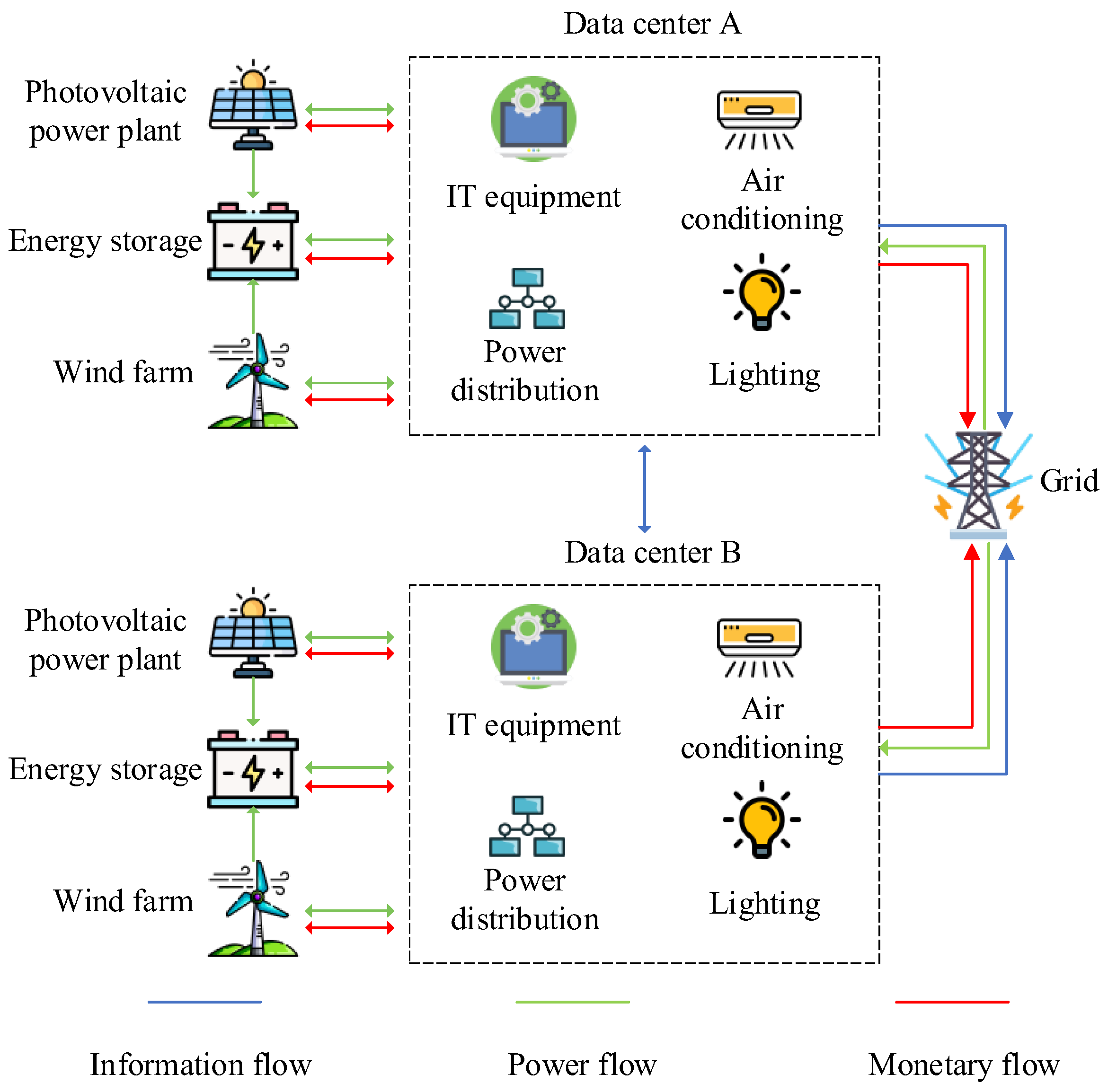
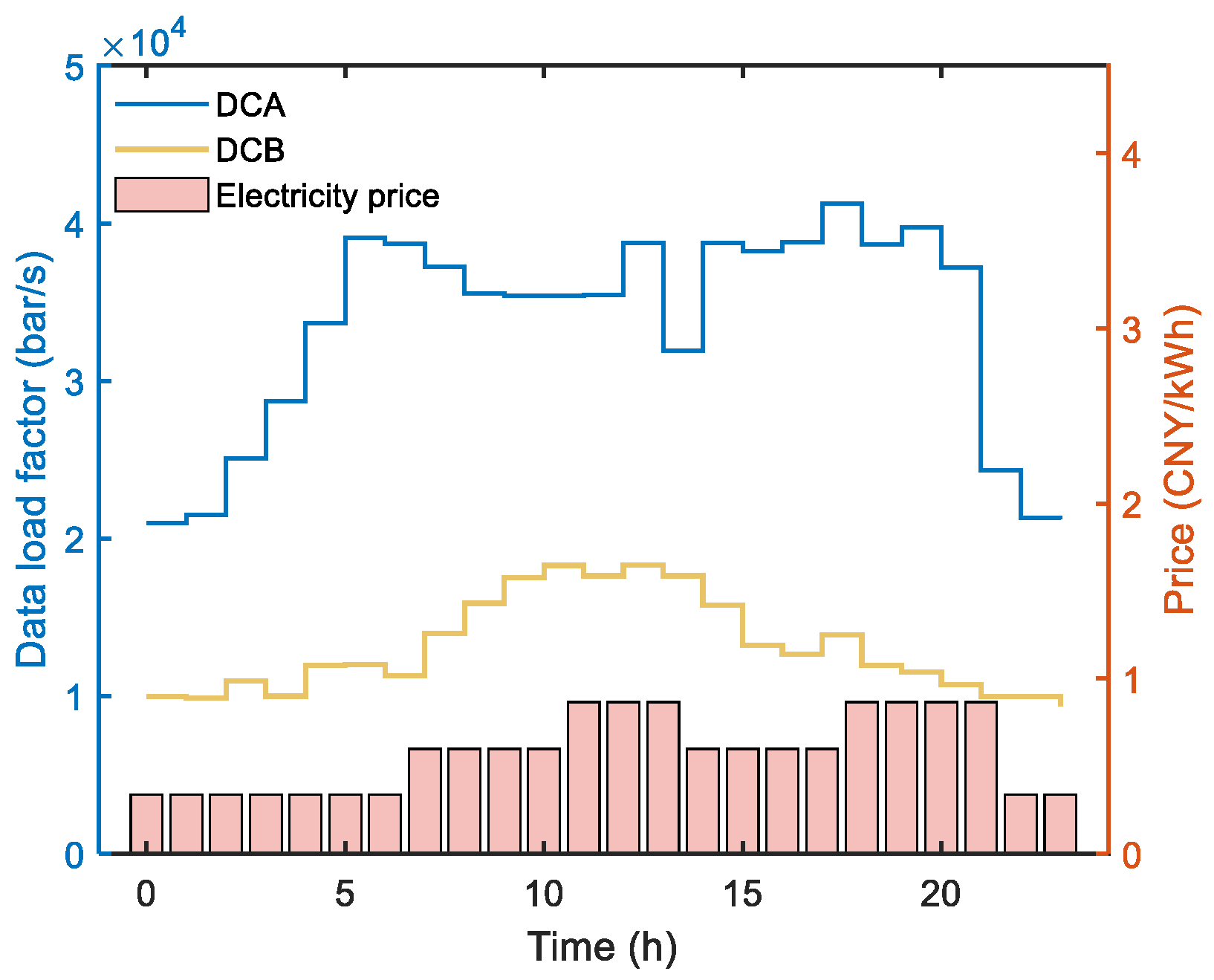
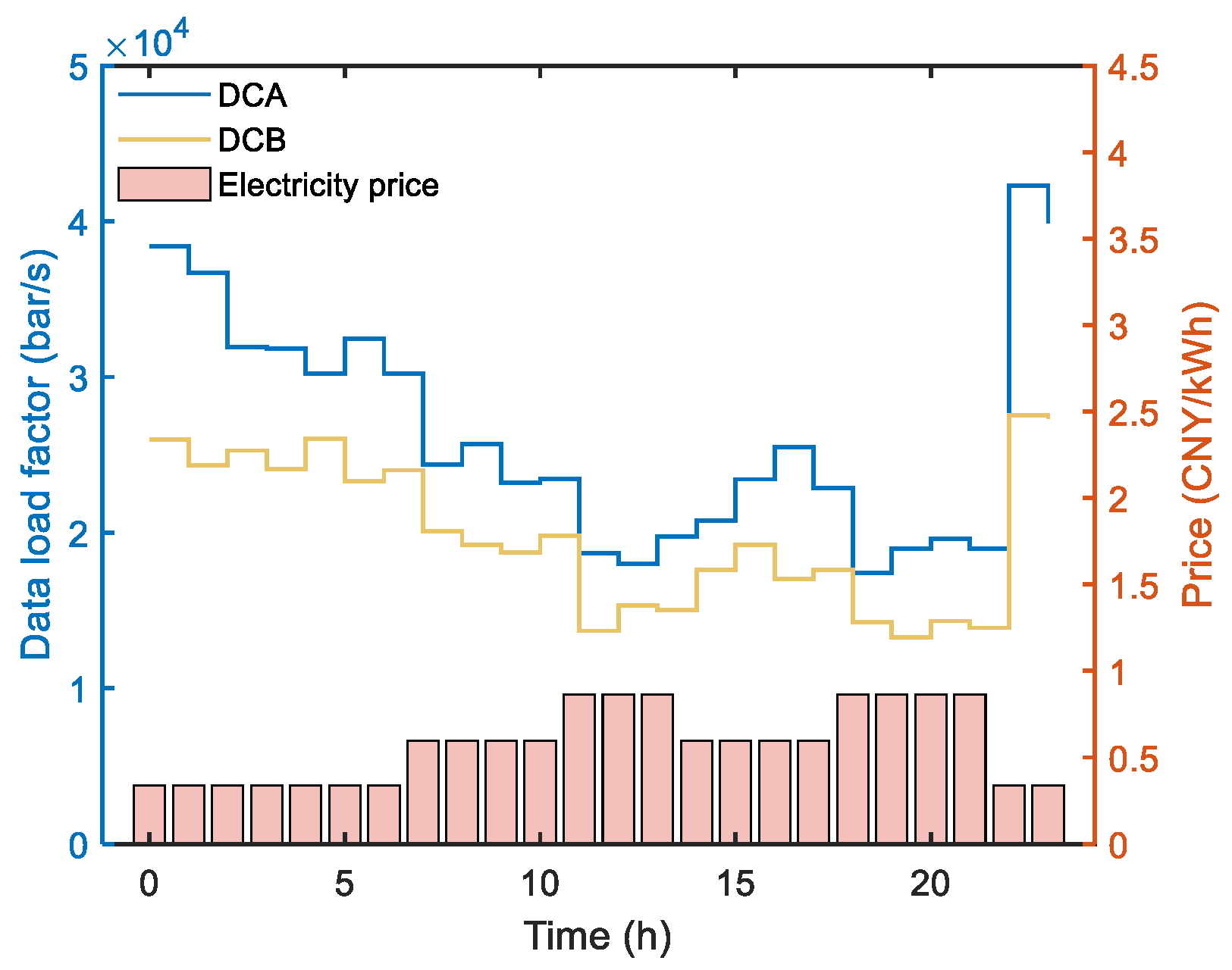


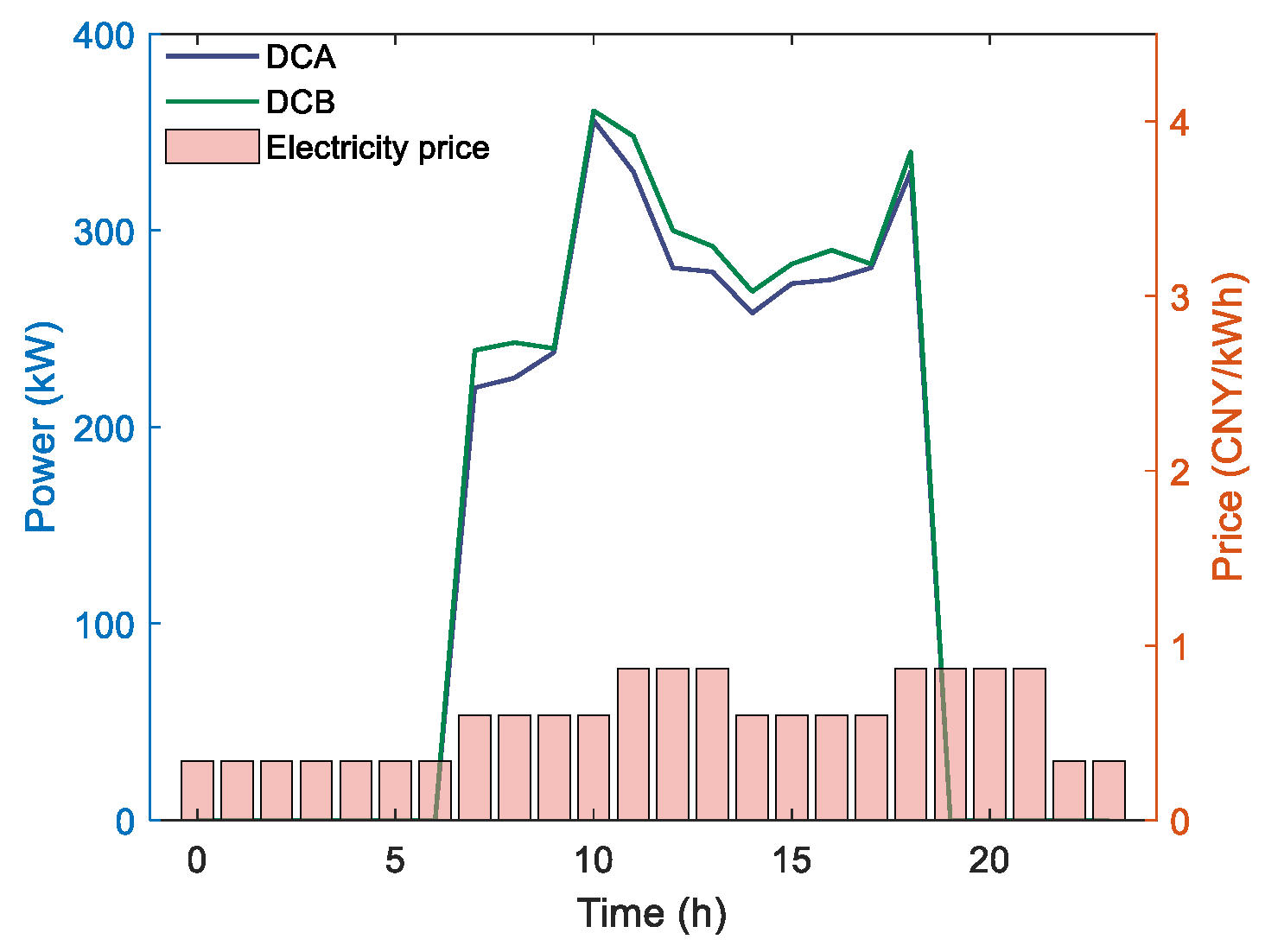

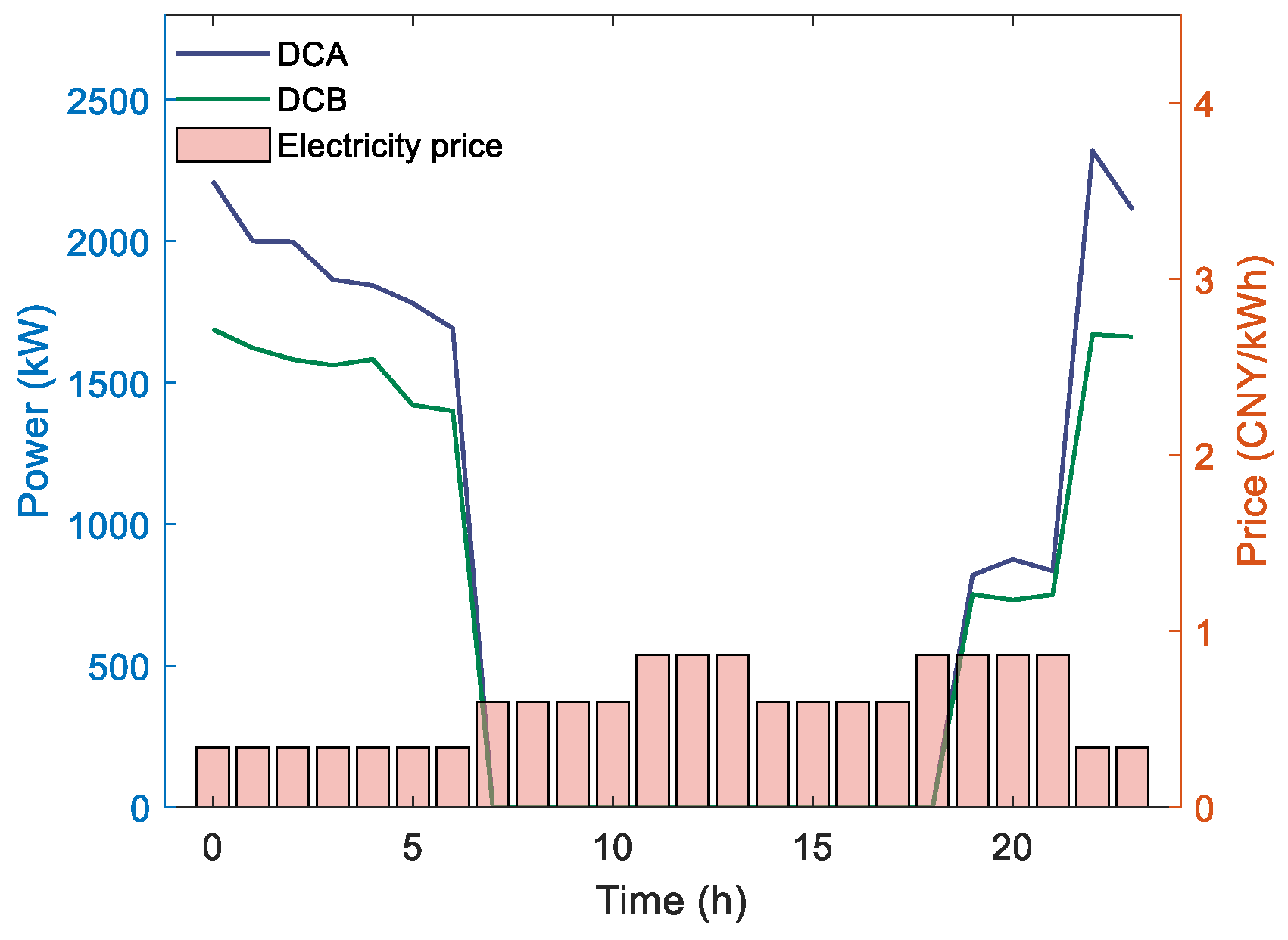
| DC A | DC B | ||
|---|---|---|---|
| Parameters | Values | Parameters | Values |
| CPU type | ADM EPYC 7003 | CPU type | ADM EPYC 7002 |
| ft (GHz) | {2.0, 2.5, 3.0, 3.5, 4.0} | ft (GHz) | {1.8, 2.3, 2.7, 3.1, 3.3} |
| μt (Bar/s) | {15, 20, 25, 30, 35} | μt (Bar/s) | {14, 18, 22, 27, 31} |
| Pm,st (W) | 80 | Pm,st (W) | 78 |
| Pm,dy,t (W/GHz3) | 8.0 | Pm,dy,t (W/GHz3) | 7.8 |
| ωPV (CNY/kWh) | 0.05 | ωPV (CNY/kWh) | 0.05 |
| ωWT (CNY/kWh) | 0.07 | ωWT (CNY/kWh) | 0.07 |
| ωES (CNY/kWh) | 0.05 | ωES (CNY/kWh) | 0.05 |
| Cases | Cost (CNY) |
|---|---|
| Case 1 | 31,126.72 |
| Case 2 | 26,470.46 |
| Case 3 | 19,324.39 |
Disclaimer/Publisher’s Note: The statements, opinions and data contained in all publications are solely those of the individual author(s) and contributor(s) and not of MDPI and/or the editor(s). MDPI and/or the editor(s) disclaim responsibility for any injury to people or property resulting from any ideas, methods, instructions or products referred to in the content. |
© 2025 by the authors. Licensee MDPI, Basel, Switzerland. This article is an open access article distributed under the terms and conditions of the Creative Commons Attribution (CC BY) license (https://creativecommons.org/licenses/by/4.0/).
Share and Cite
Qin, X.; Zhai, X.; Zhang, J.; Liu, X.; Bai, X.; Wu, C.; Chang, L.; Li, Z. Coordinated Spatio-Temporal Operation of Wind–Solar–Storage-Powered Data Centers Considering Building Thermal Inertia. Buildings 2025, 15, 1782. https://doi.org/10.3390/buildings15111782
Qin X, Zhai X, Zhang J, Liu X, Bai X, Wu C, Chang L, Li Z. Coordinated Spatio-Temporal Operation of Wind–Solar–Storage-Powered Data Centers Considering Building Thermal Inertia. Buildings. 2025; 15(11):1782. https://doi.org/10.3390/buildings15111782
Chicago/Turabian StyleQin, Xuexue, Xiangyu Zhai, Jiahui Zhang, Xiaoyang Liu, Xiang Bai, Chuanjian Wu, Longwen Chang, and Zening Li. 2025. "Coordinated Spatio-Temporal Operation of Wind–Solar–Storage-Powered Data Centers Considering Building Thermal Inertia" Buildings 15, no. 11: 1782. https://doi.org/10.3390/buildings15111782
APA StyleQin, X., Zhai, X., Zhang, J., Liu, X., Bai, X., Wu, C., Chang, L., & Li, Z. (2025). Coordinated Spatio-Temporal Operation of Wind–Solar–Storage-Powered Data Centers Considering Building Thermal Inertia. Buildings, 15(11), 1782. https://doi.org/10.3390/buildings15111782







